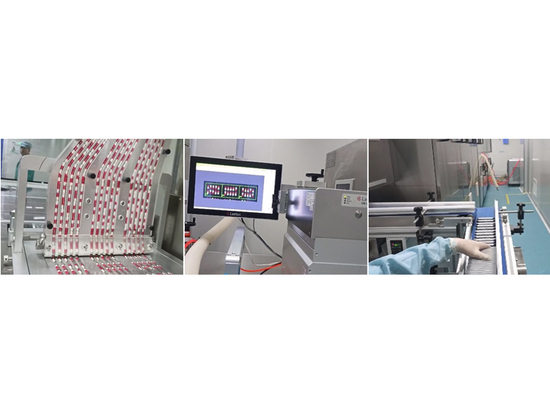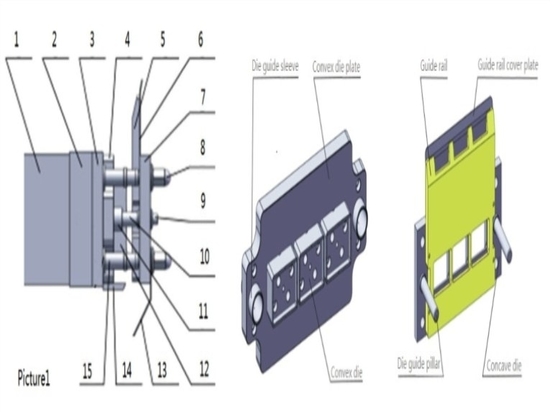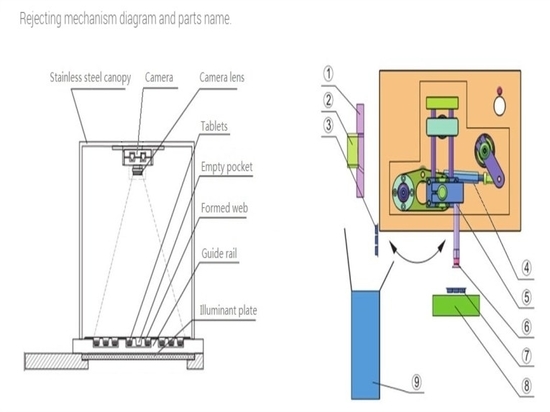
#Product Trends
The development of the Blister Machine in China
The development of the Blister Machine in China
Entrusted by Chen Husheng, Secretary General of China Association for Pharmaceutical Equipment (CAPE), I would like to talk about the development course of Blister Packaging Equipment in China. My personal ideas are all open to criticism from fellows in the industry.
First, I will introduce the origin of the domestic Blister Packaging Machine.
I remember that in March 1986, I dropped in to visit Mr. Pu Yuanming, Director of the Management Department of Shanghai Mechanical & Electrical Industry Co., Ltd. (He was ill at home then). I sincerely consulted him on the main direction of new products development. Perhaps Mr. Pu was moved by my sincerity, he directed me toward a promising field, that is, the development of pharmaceutical equipment. The industry was a blue ocean in China back then and only a few manufacturers could produce equipment of middle-low quality, while precision equipment such as pharmaceutical packaging machinery were mainly imported at a high price (At that time China was short of foreign exchange).
Luckily, I had the chance to participate in the National Pharmaceutical Machinery Exposition (1986) in Wuhan. I saw a platen style Blister Machine (Manual multiple single machine, semi-automatic) produced by Jidong Medical Device Factory on the expo. The machine looked simple and crudely made, but was surrounded by numerous people. An idea ran through my head–why not integrate forming, feeding, heat sealing, cutting and other functions in a whole set of Blister Machine?
As I researched into the market prospects of such product, I visited Hu Heli, former President of the State Pharmaceutical Administration (SPA, former Shanghai Design Institute of Pharmaceutical Machinery), and Mr. Zhang Ruhao, former Deputy Director of Pharmaceutical Machinery Division of SPA and Shanghai TCM Factory 1. Mr. Zhang was very kind and friendly. His words built up my confidence, “The authority has issued a notice about popularizing blister packaging for medicines as soon as possible in 1984, and the SPA has invested in Guangzhou to develop PTP aluminum foil and PVC production lines”.
So after funds were raised on our own and through three years of painstaking research by trial and error, we launched the first platen-style Blister Packaging Machine in September 1989 (Its original final draft has been kept from April 19, 1989 until now.) The structure and operating principle of the blister machine are as follows:
1. All positions and cams are driven by the main shaft of the machine for moving ups and downs to complete the procedures of forming, heat-sealing and cutting, while the upper and lower mold are punched closed. As the lower mold disconnects with the pull roll, it will get the PVC and aluminum foil into running (intermittent motion).
2. The pull roller is driven by quartered sheave wheels and a quarter of the roller circumference equals to the required stroke length. The machine is also equipped with printing device for online printing.
It has been 30 years since Jornen Packaging Machinery Factory, Ruian, Zhejiang, was registered in September 16, 1989.
At the National Pharmaceutical Machinery Exposition (1989) sponsored by Southern Company, former Sales Department of Far East Pharmaceutical Machine’s General Factory, the Blister Machine was favored by Mr. Chen Linxing of Shanghai-based SINE Pharmacy (PS: Its technical director who was in charge of equipment manufacturing said that the machine’s structure and operating principle were basically the same as he conceived). At the product appraisal meeting later held in Hangzhou, Mr. Chen, as a customer representative, highly appreciated this blister machine and provided valuable advice for further improvement.
The Blister Machine passed the provincial appraisal in 1991 and won the title of “Competitive Products of Zhejiang”, an award recognized by the Zhejiang Economic and Trade Commission. Meanwhile, it was granted with the Gold Award of “New Technology and Product” presented by the State Science and Technology Commission.
China’s first rotary style Blister Packaging Machine was designed by Mr. Zhu Jiesheng of SINE on March 2, 1980. Mr. Xu Dawu, technical director of former Jinzhou Packaging Machinery Factory (formerly Jinzhou Tractor Factory) led a team to investigate and study in SINE in the fall of 1980.
This machine was awarded the second prize of Science and Technology Achievement in Shanghai in 1982 and passed the accreditation of SPA in 1983. PS: The equipment was put into use in the plant in the spring of 1982.
In summary: China’s first domestic rotary style Blister Packaging Machine was designed in 1982 by Zhu Jiesheng and the first platen style automatic Blister Packaging Machine designed by Yang Yijun (founder of Jornen) came into being in 1989.
The first rotary-platen Blister Packaging Machine was researched by Mr. Lin Deping, chairman of Zhejiang Mingtian Machinery Co., Ltd. (formerly known as Donghua Pharmaceutical Machinery that was also the manufacturer of 140 type rotary style Blister Packaging Machine), and the machine was put on the market in 1996.
We can see that new generations of machines were invented every 7 years.
Second, I want to talk about the advantages and disadvantages of three styles of blister machines.
1. Rotary style Blister Machine:
(1) The 220 type of Blister Machine designed by Mr. Zhu Jiesheng (4 version/cutting) can be put into the category of rotary internal heating that is at 55 times/min of cutting frequency, while the rest of the domestic models at that time mostly adopted far infrared radiation (with heating tube) for heating, so the cutting frequency was 33 times/min.
(2) The formed roller was installed with water cooling circulation system, so as plastic sheet (PVC) close to the mold is rotated into the heating zone, the temperature range should be controlled within the limited die hole (the rest of the heat is taken away by the cooling of mold). Besides, only vacuum forming is used, which would pump the air out of the mold cavity and form the pressure (generally referred as negative pressure) by creating the pressure differences between air and the mold cavity. It will reach its limit at 1 atmospheric pressure. Given the factors above, a higher temperature is needed for forming and operators should use manual voltage regulation. Such limitation fails to secure precise control and is likely to get the temperature close to the melting point (the chlorine molecules of PVC will begin to decompose out at 180 ℃), which makes the formed blister bottom thinner and may bring about non-uniform wall thickness and suction damage. So vacuum foaming requires a higher quality of PVC sheet and cannot control the degree of sealing.
(3) This Blister Machine cannot deal with medicines of complicated shapes due to the difficulty of die & mold manufacturing.
(4) The biggest advantage of the rotary style machine is that it has no problem in synchronization between forming and sealing position.
2. Platen style Blister Machine:
The approach of platen forming is adopted.
After heating, the PVC will be pulled to the mold for forming process. The compressed air pressure is relatively high (often 0.5-0.7mpa in the process of platen forming and the required temperature is expected to reduce to about 110℃, as the PVC will start to soften at 90℃) and the heating area is large, so the blister is stretched out and formed instead of just being confined within the plastic plate of the mold cavity. Therefore, the wall thickness of the formed blister is uniform with less possibility of suction damage. In platen forming, the requirement for the quality of forming plastic sheet is declined, and the convenience of mold processing can deepen the blister (up to 35mm). At this point, the platen style Blister Machine can fit for the packaging of ampoules, vial and object of various shapes, including liquid and ointment-shaped measuring package. The machine can also adopts cold-forming process techniques for packaging of aluminum/aluminum and PVC/aluminum/PVC. Therefore, except for the application in medicine, it is widely used in industries of food, daily chemical, electronic components and medical equipment as well, in which the rotary style blister machine fails to compete. Intermittent movement is one of its disadvantages, compared with rotary style’s continuous running, which leads to a limited operating speed (A certain amount of heating time is needed to punch the upper and lower mold and force the aluminum foil to affix with PVC). So the cutting frequency of the platen-style Blister Machine at that time was generally 25 times/min. Note: Our company has offered several modified versions, mainly aiming to reduce the index time and to extend the heat-sealing time. In particular, the application of servo drive has improved the cutting frequency of DPP260, 350, 500 type machines to reach 65 times /min (standard size of blister card).
3. Rotary-platen combination style Blister Machine:
To conclude, the combination of platen forming and rotary sealing improve the work efficiency substantially. The first generation of DPH220 high-speed rotary-platen combination style Blister Machine designed by Mr. Lin Deping has a cutting frequency of 80 times/min (PS: Domestic models have full servo drive and the standard size of the blister card 80*57mm, can reach up to 200 punches/min). The disadvantage of this model is that the machine is limited by the rotary sealing, for it cannot handle well with larger object that require deeper forming and complicated shaped objects.
The third point is about the development history of China’s Blister Packaging Machine.
1. Beijing Double-Crane Pharmaceutical Equipment Co., Ltd. (former Beijing Pharmaceutical Machinery Factory) manufactured vertical rotary style blister machine (an imitation of Japan’s CKD Company) in 1980s. Its cutting frequency was about 50 times/min, but this machine did not sell well for unknown reasons. In the early 1990s, the company launched 170 and 200 type platen style blister machines. It was the first of its kind to get the blister machine connected with the cartoning machine to form a blister production line for pharmaceutical packaging. The company was owned by Double-Crane Pharmaceutical Group, an enterprise famed for strong strength and exquisite workmanship. Every time I visited the company, I would observe and learn a lot. Mr. Li Qiyun, its CEO, gave me warm and friendly reception for several times as well.
2. Oshi (former Jinzhou Packaging Machinery Factory) in the early eighties imitated and produced the FA3 platen style blister machine designed by FAC, an Italian company. Its index roller was powered by stepping motor but it was said that only 5 of them were manufactured. Because of the problem in synchronization between forming and sealing, Oshi sold the rotary style blister machine only. (PS: SINE once imported this model in 1981 for the sake of ampoule packaging, but it turned out that this high priced machine could not be put into use.) In 1998, Oshi’s core members left the factory to form Jinzhou Wande and then joined the UHLMANN Group, a German company in 2011, where they specialized in high-end manufacturing.
3. In terms of the feeding device of pharmaceutical blister packaging machine, in the early 1980s, the rotary style blister packaging machine put the feed hopper on the forming roller, just like wearing a hat. In this way, as the machine was running, the materials would fall automatically. It was applicable to sugar coated tablets and small sweet bolus, but when it came to antibiotic pills, capsules or those with irregular shapes, it would be a big challenge.
Mr. Lin Deping, one of the founders of Feiyun Machinery Factory, designed the planetary-type universal feeder in 1987 and fixed this problem. It proved that the effect remarkable! It was widely adopted by domestic peers. (PS: The former Feiyun Machinery Factory was established in 1986 and founders included Lin Deping, Yang Yijun, Zheng Yinliang, Lin Housong and the latecomer Qiu Yunbao. On April 17, 1989, upon the failure of testing on the platen style blister packaging machine, the team could not agree upon the new proposal put forward by Yang Yijun and 4 members withdrew from the project. Later on, Lin Deping reorganized the team.)
4. In 1992, Mr. Xie Zicheng told me: the pharmaceutical industry will considers the blister packaging for ampoules. Later on, we Jornen designed the clamp-packs unique structure: The press-in station gently pushes the vials or ampoules into the pocket to ensure the vials or ampoules are firmly clamped in the pocket; thus from falling from the pocket and protect them against major impacts. Also, it can be synchronized with the printer for ampoule.
5. The former Ruian Xinfei Packaging Machinery Co., Ltd. currently changes its name to Xinpai Machinery Co., Ltd. Its chairman, Mr. Ruan Zhichi once introduced the rectilinear reciprocating motion index structure in 1994 to allow platen style blister packaging machines to adjust the index range easier. Preconditions were then provided to secure the eye-mark for printing aluminum foil.
6. Shanghai Jornen started to get blister machine and cartoning machine connected in 2002, when the machine could pack 70 cartons /min. At present, once the high-speed blister packaging machine is linked with 400 cartoning machine, the efficiency can be improved to 400 cartons /min.
7. In 2016, Jack Yang, the General Manager of Jornen Machinery made innovation in designing the BMMP270H type high-speed blister packaging machine and achieved the goal of running the platen style model with high speed, a goal that the industry had dreamed of for years.
Its features are as follows:
A. The operating zone adopts a cantilever structure, which is convenient for daily cleaning and maintenance.
B. The driving zone is on the back of the machine and completely separated from operating zone at the front, thus avoiding cross-contamination.
C. The opening and closing of the mold on each position is controlled by the connecting-rod gear, of which a connecting rod pushes or pulls the toggle to handle the mold’s opening and closing. When the cam (input force) drives the connecting rod to pull the toggle almost 180° straight up (similar to the lever principle), the toggle can generate the output force vertically upward that is several times greater than the input force. This innovative structure has significantly reduced the operating pressure of the cams, and its greater output capacity can easily withstand several times the forming and heat-sealing area of the original 260 models can support. Note: The production capacity of the platen style blister machine is limited by the output efficiency of the heat-sealing (when compared to the rotary style machine). This model blister machine has enlarged the area of forming and sealing, which multiplies the capacity several times over.
D. This blister machine was operated at full servo high-speed at the cutting frequency of 150 times/min (standard size of the blister card). The speed ratio of sealing and cutting can be set within the range of 1:2 – 1:3 through HMI.
E. It is quite straightforward for format changeover.
Conclusion:
First, in the past 40 years, professionals throughout the industry have been making great efforts and learning from one another as well as introducing advanced technologies from abroad. So China’s Blister Packaging Machine has approached the international level both in performance and appearance. Our self-developed machines have been exported in large quantities all over the world (including developed countries in Europe and the United States). Great contributions are thus made to improve the overall level of China’s pharmaceutical enterprises and promote the reform of GMP!
Second, these achievements cannot be made without the correct guidance and strict supervision of industrial associations: In 1994, the National Seminar on the Quality of Blister Packaging Machine was held in Ruian; national supervision and spot inspection on the products were launched in 1995 and 1998 respectively; GMP requirements training seminars were organized for several times; and there were study trips abroad. Their efforts have been there for all to see!




